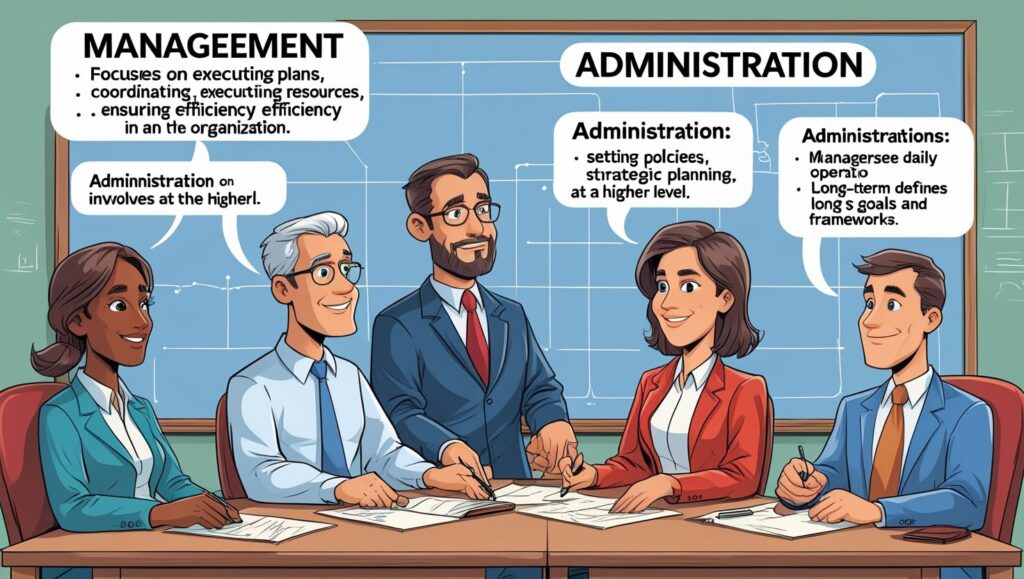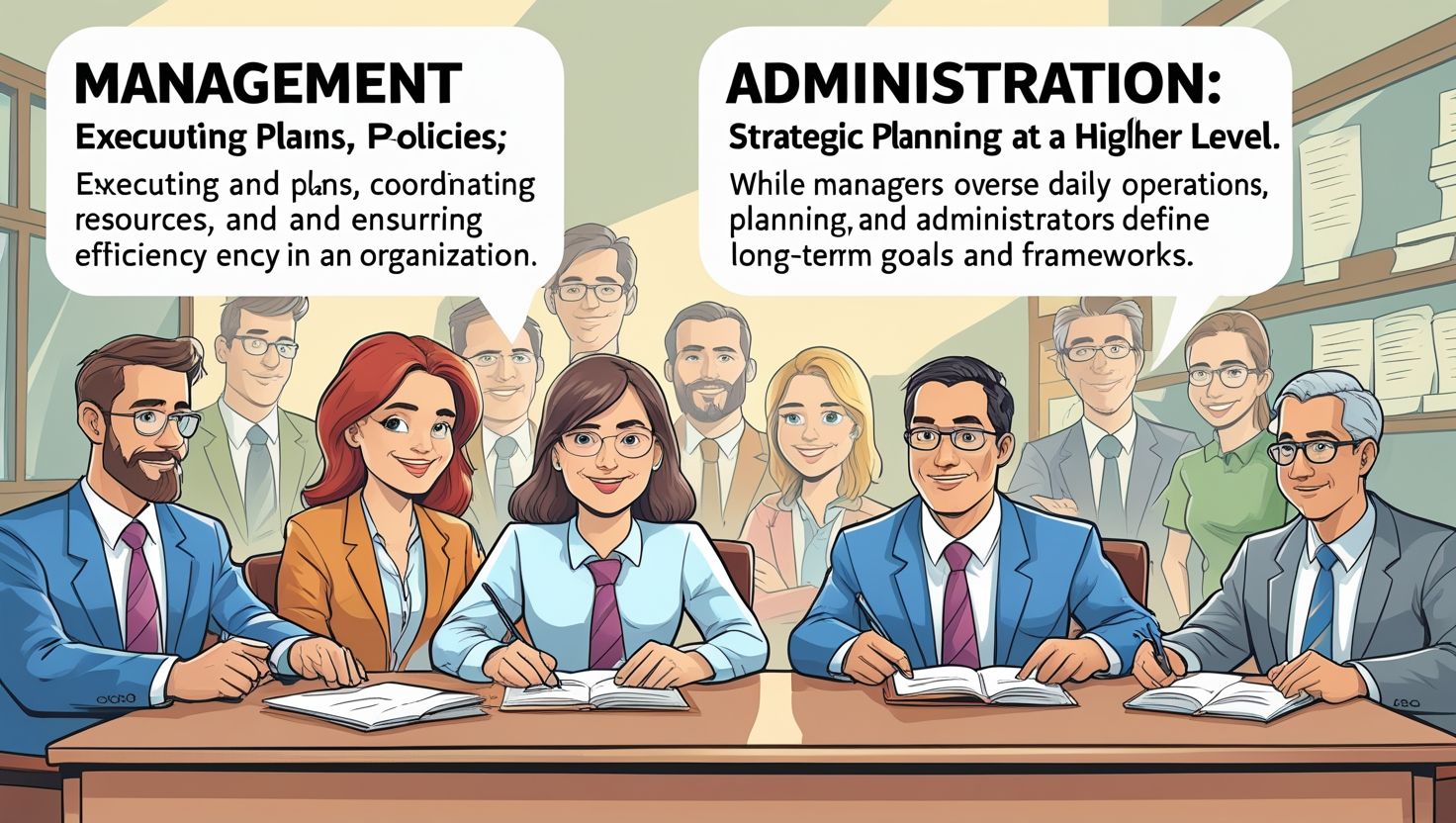Management vs. Administration, In the world of business and organizational operations, the terms “management” and “administration” are often used interchangeably. However, while they share similarities and overlap in certain areas, they are distinct concepts with unique roles, functions, and responsibilities. Understanding the differences between management and administration is crucial for anyone involved in organizational leadership, as it helps clarify roles, improve efficiency, and foster better decision-making. This article explores the key distinctions and interconnections between management and administration, highlighting their respective roles in achieving organizational success.
In education, management and administration play distinct yet interconnected roles. Educational administration focuses on policy-making, strategic planning, and decision-making at higher levels, such as government bodies, school boards, and principals. It sets long-term goals, allocates resources, and ensures compliance with educational standards.
On the other hand, educational management deals with the implementation of these policies at the institutional level. School principals, department heads, and teachers manage daily operations, curriculum execution, student discipline, and staff coordination. They ensure that educational objectives are effectively met within the framework set by administrators.
While administration provides direction and structure, management ensures efficiency and execution. Both are essential for a well-functioning educational system, as administration establishes policies, and management translates them into actionable plans that enhance student learning and institutional growth. Effective collaboration between both ensures quality education and institutional success.
Defining Management and Administration
Management refers to the process of coordinating and overseeing the work of others to achieve organizational goals. It involves planning, organizing, directing, and controlling resources, including people, finances, and materials. Managers are responsible for executing strategies, motivating employees, and ensuring that day-to-day operations align with the organization’s objectives. Management is often seen as a hands-on, action-oriented function that focuses on achieving results through teamwork and effective resource utilization.
Administration, on the other hand, is concerned with the formulation of policies, setting objectives, and making high-level decisions that guide the organization. It is a broader concept that encompasses the overall direction and governance of an organization. Administrators are typically involved in strategic planning, policy-making, and ensuring that the organization complies with legal and regulatory requirements. Administration is often associated with leadership and decision-making at the highest levels of an organization.
Key Differences Between Management and Administration
While management and administration are closely related, they differ in several key aspects:
1. Scope and Focus
- Management has a narrower focus and is primarily concerned with the execution of tasks and the implementation of policies. Managers work to achieve specific goals within the framework set by administrators.
- Administration has a broader scope and focuses on the overall direction and governance of the organization. Administrators are responsible for setting the vision, mission, and long-term objectives of the organization.
2. Level of Authority
- Management operates at the middle and lower levels of the organizational hierarchy. Managers are responsible for supervising employees, allocating resources, and ensuring that tasks are completed efficiently.
- Administration operates at the top level of the organizational hierarchy. Administrators, such as CEOs, board members, and senior executives, have the authority to make high-level decisions that affect the entire organization.
3. Nature of Work
- Management : action-oriented and involves day-to-day operations. Managers focus on solving problems, improving processes, and achieving short-term goals.
- Administration: decision-oriented and involves long-term planning and policy formulation. Administrators focus on shaping the organization’s future and ensuring its sustainability.
4. Decision-Making
- Management involves tactical and operational decision-making. Managers make decisions related to resource allocation, workflow, and employee performance.
- Administration involves strategic decision-making. Administrators make decisions related to organizational structure, policy changes, and major investments.
5. Skills and Competencies
- Management requires skills such as communication, teamwork, problem-solving, and time management. Managers need to be adept at motivating employees and managing conflicts.
- Administration requires skills such as strategic thinking, leadership, vision-setting, and policy analysis. Administrators need to have a deep understanding of the industry, market trends, and organizational dynamics.

Interconnection Between Management and Administration
Despite their differences, management and administration are interconnected and interdependent. Both functions are essential for the success of an organization, and they work together to achieve common goals. Here are some ways in which management and administration are interconnected:
1. Shared Objectives
- Both management and administration aim to achieve the organization’s goals and objectives. While administrators set the vision and mission, managers work to translate these into actionable plans and ensure their execution.
2. Collaboration
- Effective collaboration between administrators and managers is crucial for organizational success. Administrators rely on managers to provide feedback on the feasibility of policies and strategies, while managers depend on administrators for guidance and support.
3. Continuous Feedback Loop
- Management and administration operate in a continuous feedback loop. Managers provide administrators with insights into operational challenges and employee performance, which helps administrators refine policies and strategies. Conversely, administrators provide managers with the resources and direction needed to achieve organizational goals.
4. Adaptability
- Both functions require adaptability in response to changing internal and external environments. Administrators must adjust policies and strategies based on market trends and organizational performance, while managers must adapt their approaches to meet evolving operational demands.
Examples of Management and Administration in Practice
To better understand the differences and interconnections between management and administration, let’s consider a few examples:
Example 1: Corporate Organization
- Administration: The board of directors and CEO of a corporation are responsible for setting the company’s strategic direction, such as entering new markets or launching new products. They make high-level decisions about investments, mergers, and acquisitions.
- Management: Department heads and team leaders are responsible for implementing the strategies set by the administrators. For example, the marketing manager develops campaigns to promote the new product, while the operations manager ensures that production meets demand.
2: Educational Institution
- Administration: The school board and principal set policies related to curriculum, admissions, and budgeting. They decide on the long-term goals of the institution, such as improving academic performance or expanding facilities.
- Management: Teachers and department heads manage the day-to-day operations of the school. They implement the curriculum, monitor student progress, and ensure that resources used effectively.
3: Healthcare Facility
- Administration: Hospital administrators, such as the CEO and board of trustees, are responsible for setting policies related to patient care, budgeting, and compliance with healthcare regulations. They make strategic decisions about expanding services or adopting new technologies.
- Management: Department managers, such as the head of nursing or the chief of surgery, oversee the delivery of patient care. They ensure that staff are trained, resources allocated efficiently, and protocols are followed.

The Importance of Balancing Management and Administration
For an organization to thrive, it must strike a balance between management and administration. Overemphasis on one at the expense of the other can lead to inefficiencies and missed opportunities. For example:
- Too much focus on administration without effective management can result in well-crafted strategies that fail to be executed properly.
- Conversely, too much focus on management without strong administration can lead to a lack of direction and poor decision-making at the top.
Organizations that successfully balance both functions better equipped to adapt to changes, achieve their goals, and maintain a competitive edge in their industry.
Conclusion
Management and administration are two sides of the same coin, each playing a critical role in the success of an organization. While administration focuses on setting the vision, policies, and long-term goals, management is responsible for executing these plans and ensuring that day-to-day operations run smoothly. By understanding the differences and interconnections between these functions, leaders can create a more cohesive and effective organizational structure. Ultimately, the synergy between management and administration is what drives organizations toward sustained growth and success.
In a rapidly changing business environment, the ability to balance strategic decision-making with operational efficiency is more important than ever. Organizations that recognize and leverage the unique strengths of both management and administration will be better positioned to navigate challenges, seize opportunities, and achieve their objectives.

7 thoughts on “Management vs. Administration in Education”
Comments are closed.